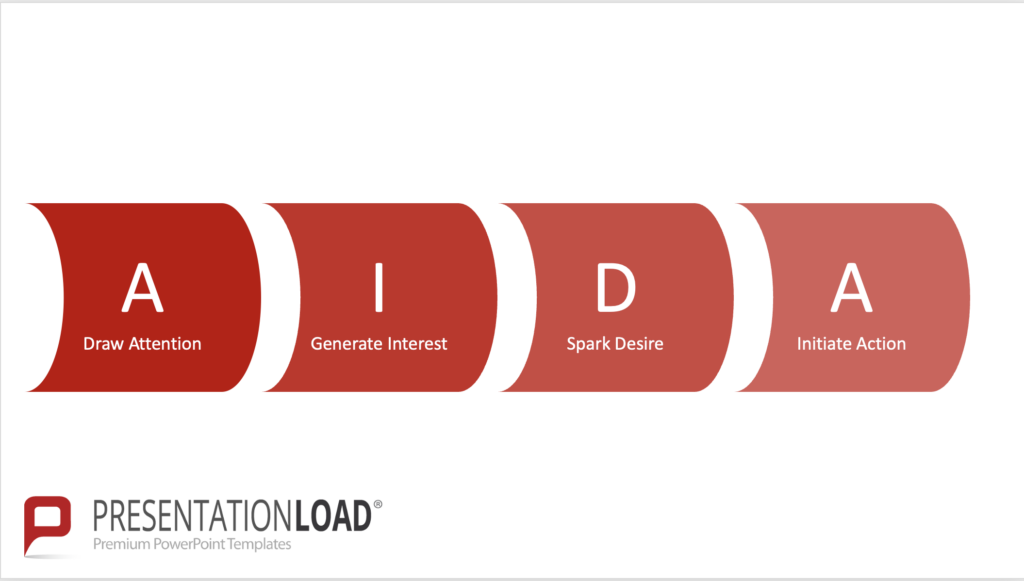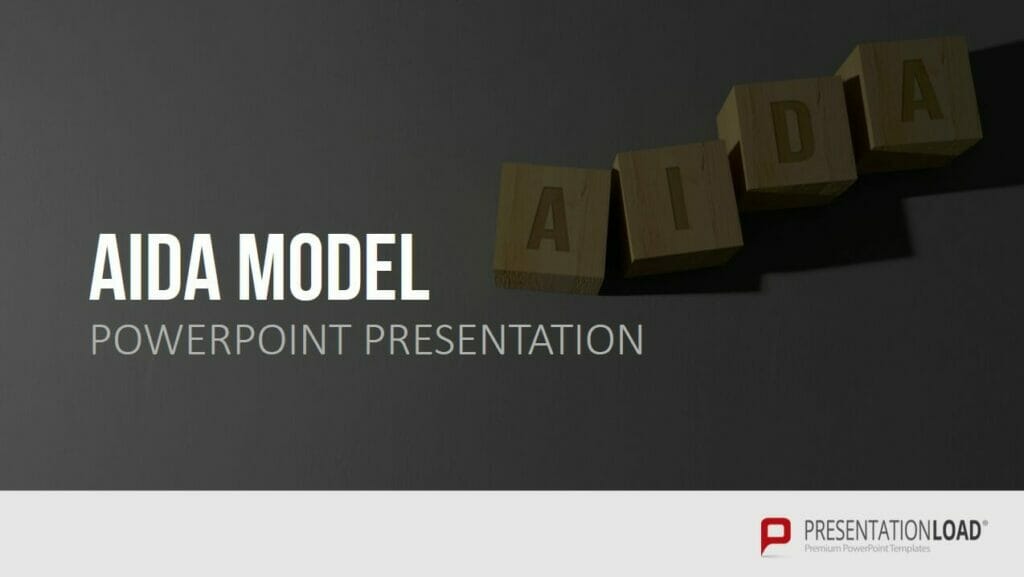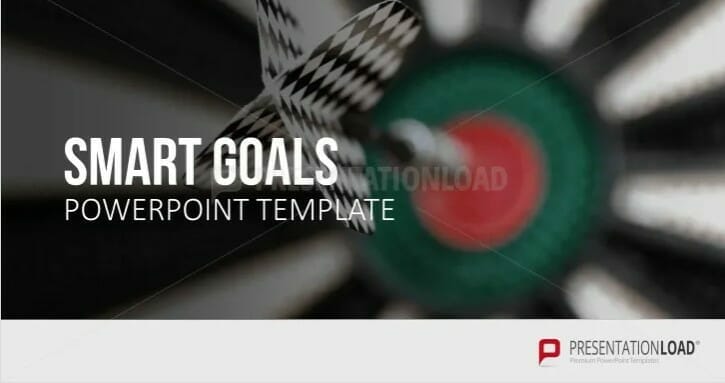
Preparing a PowerPoint Presentation: 11 Tips for Guaranteed Success!
In 2022, presentations are part of everyday life for anyone in business. Many people find it difficult to put together presentations that are both target-oriented and interesting, though. Getting the preparation and structuring right from the start is the basis of a successful presentation.
A cogent and professionally presented presentation connects you to your clientele by allowing them to clearly understand your topic. Since good preparation accounts for up to 50% of the success of a presentation, we have compiled 11 tips for you to follow in order to deliver a great presentation and make a good impression.
Preparing presentations thoroughly: Why is it so important?
The best and most successful presentations are based on solid, well-researched and meticulously prepared content. Preparing your presentations properly means you will be faster, more efficient and ultimately more successful in both immediate and future presentations. The most important thing is a good structure – the mainstay of any presentation.
A good structure allows you to deliver a professional and well-thought-out presentation that will resonate with your audience and convince them of your points. A good structure is also vital to you as the presenter, as it provides a common thread to follow throughout your presentation.
Preparing properly will exude professionalism and give you confidence in your delivery.
Preparing a PowerPoint presentation: How much time do I need?
You have a presentation coming up in a few weeks – so when should you start preparing? Unfortunately, there are no hard-and-fast rules. The time you need to prepare depends entirely on what you’re going to be presenting, your knowledge of the subject, your presentation experience and your PowerPoint skills. (Don’t worry; we’re here to help with the latter!)
There is, however, a useful rule of thumb attributed to Wayne Burgraff, an 18th century American philosopher:
“It takes one hour of preparation for each minute of presentation time.”
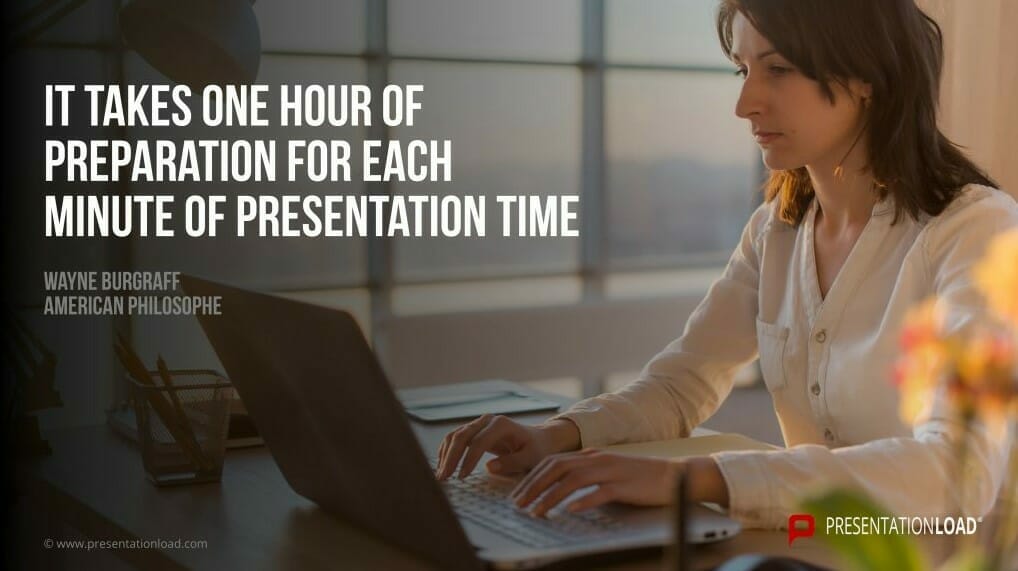
So, start your preparation as early as you can. It’s better to finish your preparations a little too early than to start too late and deliver a substandard presentation while feeling panicked.
Preparing a PowerPoint presentation: Questions to ask in advance

Whatever you intend to present, there are a few basic questions that apply regardless of the topic. Part of your preparation should include answering these for yourself. These are:
- What is the goal of your presentation?
- Who is the target audience? (Level of knowledge, jobs, age, expectations).
- How big will your audience be?
- What is the topic? What is your core message?
- How much time do you have for your presentation?
- What is the space you have to present in like? What technology (projector, laptop, microphone) might you use or need to bring? If presenting remotely, have you mastered the form?
- Where can you find any necessary information about your topic?
- Have you planned a good structure? (Tips here)
- How do you make your slides visually appealing? (Design, graphics, photos, videos, font size)
- How do you make the presentation interesting? (humor, anecdotes, etc.)
- Have you rehearsed your presentation (noting particularly how long it lasts, and how your rehearsal audience reacts)? Where can you shorten it if needs be on the day?
- Are there speaking techniques which might help you when presenting? (Tips here)
- Are you aware of your gestures and facial expressions, and what should you wear to appear as professional as possible? (Tips here)
- How would you deal with technology breaking down? (Tips here)
- Are you prepared for questions? Have you factored in time for them?
We’ve compiled 11 tips and tricks to help you answer these questions, ensuring a really professional presentation and a happy audience!
Preparing a PowerPoint presentation: 11 tips for success
1. Structure is all-important

A solid structure is the mainstay of any presentation. It provides a logical, common thread for both your audience and yourself. Structuring your presentation well allows you to communicate your points coherently and professionally. So what do we mean by structure?
The basic outline is elegantly simple:
- Introduction
- First subtopic
- Second subtopic
- Third subtopic
- Conclusion
Following your conclusion, you should allow time for questions and be prepared to answer them. This is especially important if one of your goals is networking. More information on networking can be found here.
We’ve written a detailed article covering presentation setup and structure here.
2. What is your core message?
It is important for both you and your audience to deliver your core message effectively.
This means you need to work out in advance what it is. It needs to be as concise as possible, but thoroughly internalized by you, and comprehensible to your audience. Once you know exactly what it is, it will help clarify the structure you need in your presentation.
Tip: Why not try using a mind map to clarify what your core message is? Which are the most important aspects? What are your main arguments, and how are they linked? It’s a really useful exercise, which you can use to crystallize your core message and structure your presentation, by actually seeing how the various aspects of your presentation are interlinked. For more tips on developing a core message, see this post. We’ve also written about how to convey your core message in the headline, with an action title, here.
3. Make sure you have a strong start and finish
An important aspect of preparing a presentation is to formulate a good introduction and a convincing ending. Both are necessary for a well-rounded and coherent presentation.
It’s vitally important, especially at the beginning of a presentation, to get the audience’s attention. If you lose this, it doesn’t really matter what you say during the rest of the presentation as they won’t be listening. This article shows you how to create an interesting introduction; one which doesn’t trot out the usual tired phrases.
It’s also well worth putting preparation time into working out how to finish. Once again, empty phrases will send your audience away dissatisfied, even if they have been with you until then. Take the time to craft an ending that is both purposeful and effective; you may even be able to include a call-to-action. We have more tips and ideas here.
4. Use a good layout and design to get your message over
When putting your presentation together, put yourself in your audience’s shoes: What would make you pay attention? Are your slides in danger of being boring? How can you use the design options offered by PowerPoint to make the most impact?
Taking a bit of time to answer these questions in advance pays off – you can score points with your audience by thinking about these things. No matter how well thought out and professionally delivered your presentation is, if your slides look unprofessional, your audience won’t take your points as seriously. Your presentation needs to be visually appealing to your audience to let them really take notice of your ideas.
So thinking about a good design and layout for your slides, one that visually supports your purposes and your presentation, is a good use of your preparation time.
A variety of slide formats, with an overall coordinated theme, is optimal. There are many options in PowerPoint, and we’ve written about them here. You can incorporate impactful graphics, interesting pictures to make your point, or even play with animations.
5. Prepare a handout
When you’re putting your presentation together, don’t forget to make a handout too. You may think they’re just for academic presentations, but handouts can be really useful for business presentations when used correctly.
A handout should provide added value. Just jotting down a few sentences from your presentation without much thought is counterproductive. A handout should be a brief summary of the presentation that the audience can understand without the presentation.
Think about when and how you want to distribute your handout. You’ll need to take a number of factors into account, so we’ve covered that here, as well as tips on creating effective handouts.
6. Is the necessary technology working?
This is something that many people overlook when preparing presentations. If the technology you need doesn’t work, your lecture and presentation can be as sophisticated as you like, but without being able to present it to your audience, it’s useless.
If possible, visit your presentation venue in advance, to familiarize yourself with how it feels and prepare for any problems or lack of technical equipment.
Make at least two copies of your presentation (for example, one on your laptop and another on a USB stick or similar). This helps avoid disaster on the day of the presentation.
It’s also important to take a spare battery and a charging cable with you. It’s hard to convince your audience when the battery dies in the middle of your presentation and you’re left with a blank screen.
7. Prepare for a question and answer session and indicate your willingness to interact with your audience
If your audience is interested in what you’re saying during your presentation, they will often have questions. Work out in advance when you want to include time for questions; this can be at the end or as you go along. How much time you include for Q&A depends entirely on your topic, and how knowledgeable your audience is.
Allow enough time to answer all the questions, because the goal of any presentation is to convince your audience. Answer politely and as thoroughly as possible. We have more about how to plan and deliver question-and-answer sessions here.
You might end up with questions or suggestions that overflow the Q&A session, so plan some time after the end of your presentation to be available for interested listeners. This is especially if you are wanting to network or sell a product with your presentation, as you have time to interact with potential customers.
8. Prepare to deliver your presentation

It’s not enough just to plan the contents of your presentation; you also need to think about how you present what you’ve prepared. One of the most important presentation techniques is relaxed improvisation, but this sounds a lot easier than it is, and requires a lot of practise.
One way to help here is to use index cards with bullet points to keep your train of thought on track. Reading the entire speech from index cards, however, is counterproductive.
PowerPoint presenter view is a really useful too here. This featureg lets you follow your presentation on the screen in front of you, but also see the next slide and any notes you’ve made. We write all about presenter view in this article.
In general, improvisation works better if you really know your topic and have practiced your presentation a few times in advance. Co-opting a test audience to listen to your rehearsal helps to recreate the situation as authentically as possible.
To make the presentation as relaxed as possible, you can use humor in sparing doses and at appropriate points. Starting with an anecdote is one example; we go into more ways of incorporating humor in this article.
There are also speech techniques that can help you deliver your presentation really effectively. They include stylistic elements such as exaggeration or other rhetorical devices (really not as offputting as they sound!). Practice using your voice, working with the right pitch and emphasis. We’ve put together those and many more speaking technique tips to help you score points in your presentation here. If you happen to make a mistake in your presentation despite all that preparation, it’s not a disaster. It makes you human. You can prepare to laugh it off, or use the techniques that we have collected in this article to sail confidently over the hiccup.
9. More important than you may think: what you wear, your gestures and facial expressions
So you’ve prepared your presentation thoroughly, and taken our tips to heart? Brilliant! Now don’t forget to optimize your body and your gestures and facial expressions to reinforce the points you make so eloquently in your presentation.
Your appearance is, unavoidably, the first thing your audience will notice. If you look unprofessional, or inappropriately dressed for the occasion, you will struggle to convince them of your ideas, so it’s worth planning what to wear beforehand. As a general rule, avoid clothing that is too garish or colorful, as this can distract from your presentation. Tips on choosing the right outfit can be found here and here. Standing lifelessly in front of your audience with your arms hanging down makes you appear listless, while a grimace on your face will turn people off quickly. Underline important aspects with good body language or a smile. You can find really useful tips on body language and gestures in this article.
10. Extra tip: what if you’re presenting online?
So your presentation is going to take place online and not on site? Basically, this doesn’t make any difference in how you prepare your presentation, but there are some minor differences that you should be aware of.
PowerPoint offers a slimmed-down online version of its service. Information on this can be found here. You can of course also fall back on the familiar desktop version.
With an online presentation, the interaction with your audience changes. Because you are not in a room together, you have to deal with your audience differently and also adapt your presentation accordingly. Your content and face is also more in focus due to live screen presentation. This is all covered here.
Technology is even more important here than when presenting on site. Think about which platform you want to share your presentation on and what options you need from it. We compare the various online presentation tools now available here.
11. Another extra tip! Use the AIDA and SMART methods to help you.
Depending on what you want to achieve from your presentation, there are a couple of methods which can help to guide your presentation preparation: the AIDA method and the SMART method.
If you want to sell products with your presentation, the AIDA method is perfect. This model (also known as the AIDA principle) is a step-by-step model developed by Elmo Lewis as long ago as 1898 to optimize advertising.
It is an acronym for the terms describing the four successive phases which everyone goes through before deciding to purchase a product or service:
A = Attention: Grab your audience’s attention and they’ll listen to what you’re trying to say. Make your presentation appealing and stand out from the crowd.
I = Interest: Generate interest in the product.
D = Desire: Awaken the audience’s desire to possess your product. This is where you can use the emotional and cognitive level to make your product more desirable.
A = Action: Get the audience to actually buy the product. You can use call-to-actions for this purpose, for example.
If you want to you can use our AIDA PowerPoint Templates:
If your presentation is more about conveying information, then the SMART principle is tremendously useful. This helps you to define and set concrete presentation goals:
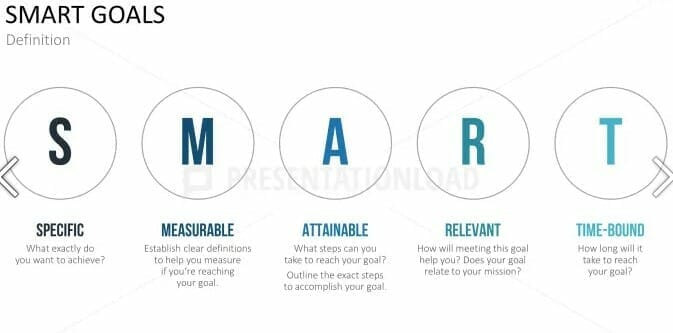
S = Specific: Make your presentation as concrete as possible. Vague statements won’t help your presentation. Concretize your goal in one sentence if possible and build your presentation around it.
M = Measurable: You should be able to assess how well you are achieving your goals at certain points.
A = Action-oriented/attractive: Interact with the audience (e.g., through questions or discussions). This will complement a well-prepared presentation, to help achieve your goals.
R = Realistic: Make sure that everything you plan is actionable.
T = Timed: How much time do you plan to spend on each item?
These five steps, help you to create a focused and engaging presentation. If you want to you can use SMART Goal PowerPoint Templates from PresentationLoad:
Preparing a PowerPoint presentation: Our tips make it easy, efficient and effective!
Now you know how to prepare presentations as effectively as possible. Our tips and tricks make it easy to create a successful presentation that will help you achieve your goals.
So take the time you need to prepare all aspects of your presentation and delivery thoroughly. Remember, good preparation accounts for 50% of success!
Have questions about this article or other aspects of presentations or PowerPoint? Do feel free to contact us via [email protected]. We are always happy to help!
The following articles might also be of interest:
